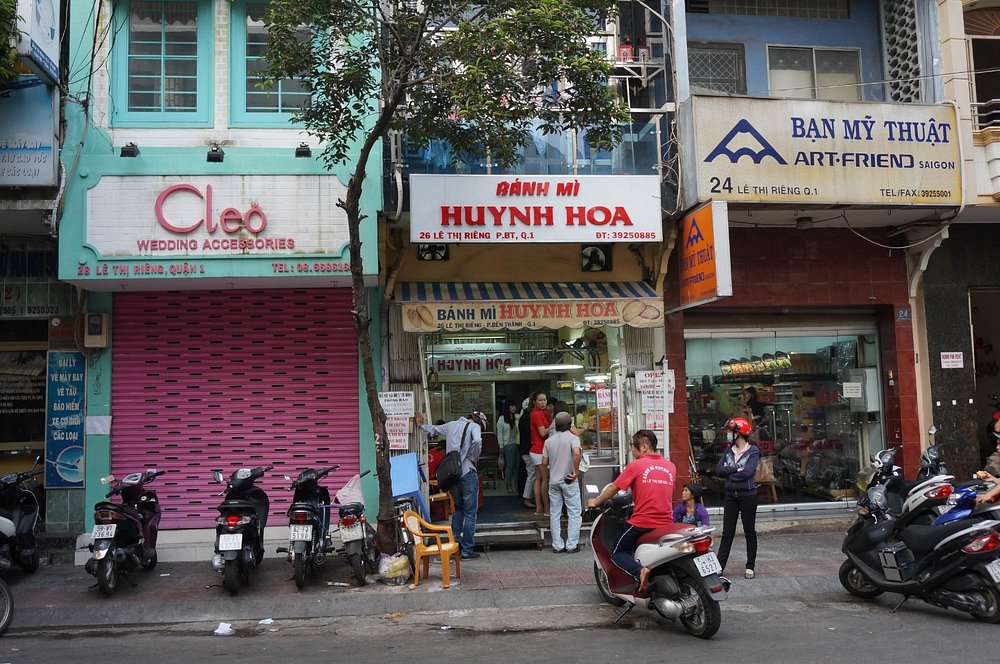Ho Chi Minh City, located in the south of Vietnam, is one of the country’s largest and most dynamic cities. Formerly known as Saigon, it has a rich history and culture, offering both traces of the past and modern Vietnam side by side. The city is filled with significant sites that reflect historical events, from French colonial architecture to the Vietnam War. It is also famous for its vibrant street markets, breathtaking temples, and delicious street food. Ho Chi Minh City stands out as a destination full of diverse activities that offer visitors both cultural and entertaining experiences.
Ho Chi Minh also draws attention with its wide shopping avenues, luxury malls, modern restaurants, and café culture. The city represents the modern face of Vietnam in the best way through its energetic nightlife, historical buildings, and colorful streets. Its proximity to the Mekong Delta and historical sites like the Cu Chi Tunnels makes it a great hub for travelers looking to explore. Ho Chi Minh City offers a variety of places to visit for both history enthusiasts and adventure seekers.
🏛️ Historical and Cultural Sites
1. Reunification Palace (Bağımsızlık Sarayı)
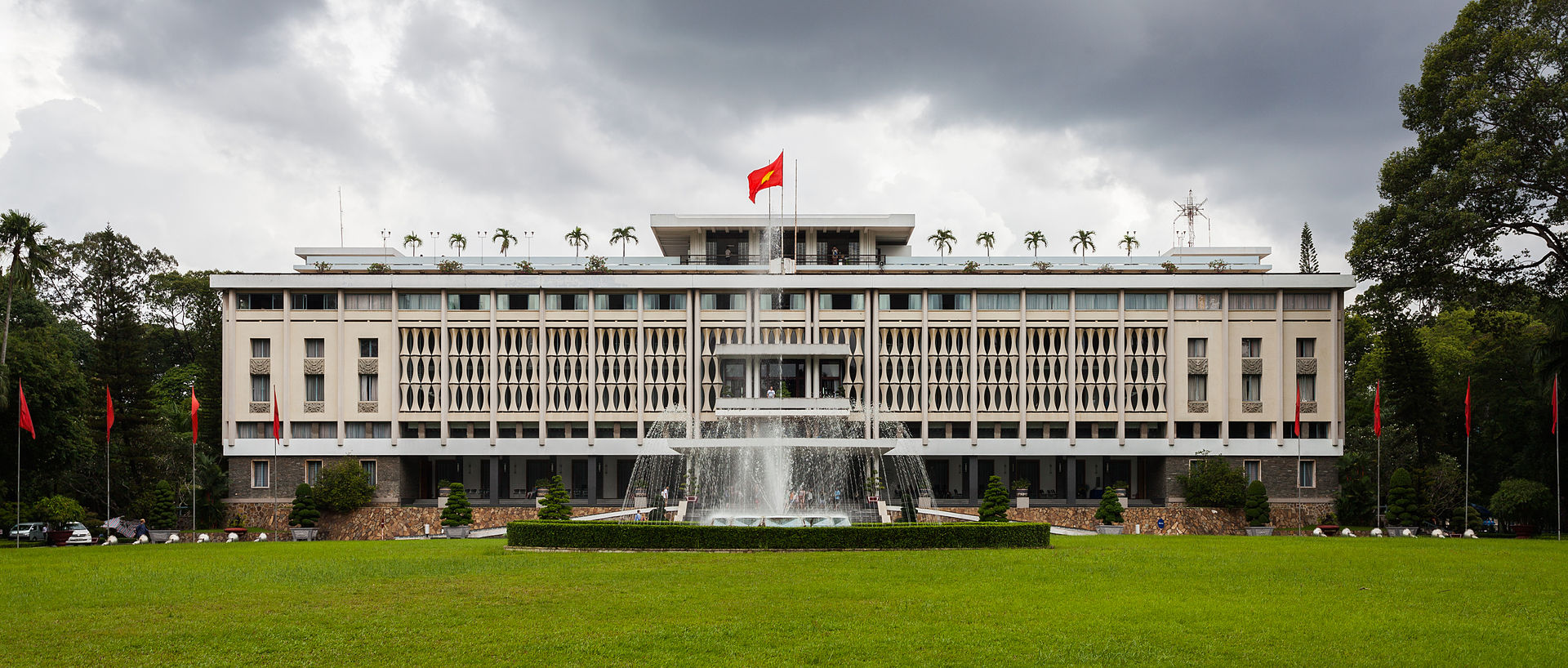
The Reunification Palace is one of the most iconic structures in Ho Chi Minh City and symbolizes one of the turning points in Vietnam’s history. Built in 1966, this palace was the site of events that marked the end of the Vietnam War and the fall of South Vietnam. On April 30, 1975, North Vietnamese tanks reached the gates of the palace, officially toppling the South Vietnamese government. This historic event symbolizes the reunification of Vietnam and the end of the war. The palace has become one of the symbols of modern Vietnam and holds great historical and cultural significance.
As you step into the palace, you can witness the grandeur of the era and the luxury of the pre-war South Vietnamese government. The interior design of the palace reflects the French colonial influence of the period, complemented by furnishings and decorations in the style of the 1970s. Additionally, the underground tunnels located beneath the palace were used as shelters during the war and offer visitors the opportunity to explore these hidden passages. The Reunification Palace offers not just a structure, but a historical experience that brings to life one of the most significant turning points in Vietnam’s history.
2. War Remnants Museum (Savaş Suçluları Müzesi)
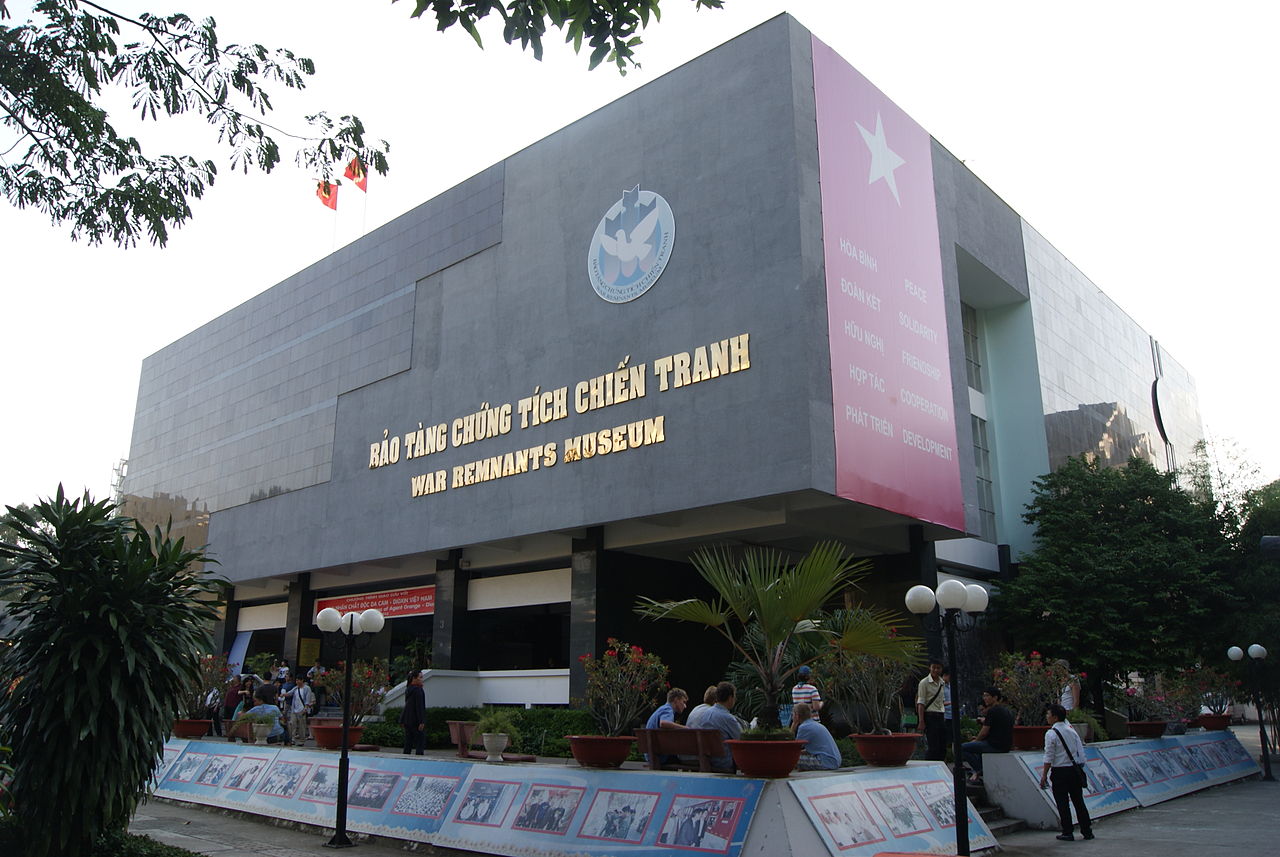
The War Remnants Museum is one of the most important museums that reveals the horrors and impacts of the Vietnam War. Located near the center of Ho Chi Minh City, this museum houses a collection that documents the lasting effects of the war on the Vietnamese people. The museum presents numerous photographs, documents, weapons, and wartime equipment that depict human rights violations, torture, bombings, and the horrors of chemical warfare. Additionally, in the outdoor area of the museum, large military vehicles such as planes, helicopters, and tanks used during the war are exhibited, allowing visitors to grasp the scale of the conflict in a tangible way.
The museum offers a comprehensive narrative of the war’s impact on both the military and the civilian population. Visitors pay particular attention to sections that illustrate the effects of chemical weapons like Agent Orange and the consequences of the war. The War Remnants Museum is not only about the Vietnam War but also serves as an educational space that shows the devastating nature of wars and human rights violations to the entire world. Through these in-depth and sometimes shocking exhibits, visitors gain a deeper understanding of the tragic realities of war.
3. Notre-Dame Cathedral

Notre-Dame Cathedral is one of the most recognizable landmarks of Ho Chi Minh City and a graceful example of the French colonial era. Built between 1863 and 1880, this cathedral bears the marks of Gothic architecture brought to the city by the French. Its exterior is made of red bricks, and it stands out with its tall towers and elegant stained glass windows. Located in the heart of Ho Chi Minh City on one of its busiest streets, Le Duan Street, the cathedral serves as an important place of worship for both tourists and locals. It is a significant structure symbolizing Vietnam’s Christian heritage and French influence.
Inside Notre-Dame Cathedral, large stained glass windows and chandeliers draw attention. This place of worship and religious ceremonies also offers a peaceful atmosphere reflecting the city’s historical ambiance. The cathedral is not only a retreat for those wanting to escape the city’s noise but also holds central importance for the Christian community in Vietnam. Visitors can step away from the outside crowd for a moment and experience the spiritual ambiance of this historical structure. As one of the most important remnants from the French colonial period, Notre-Dame Cathedral is a must-visit spot for every tourist coming to Ho Chi Minh City.
4. Saigon Central Post Office

The Central Post Office is one of the most striking buildings in Ho Chi Minh City and offers a graceful example of French colonial architecture. Constructed between 1886 and 1891, this historic building was designed in a style similar to the Eiffel Tower by French engineer Gustave Eiffel. The building’s exterior is adorned with classical French elements, while its spacious central hall features impressive stained glass windows, high ceilings, and intricate details. The Central Post Office is one of Ho Chi Minh City’s most important landmarks and is considered a must-see spot for visitors to the city.
The Central Post Office goes beyond being merely a postal facility by offering tourists the chance to enjoy beautiful architecture within a historic structure. Inside the building, original elements such as old telephone lines and nostalgic postal machines have been preserved, providing visitors with glimpses of the past. Additionally, a map symbolizing Vietnam’s struggle for independence is displayed inside the post office. This map, which shows the city before the French colonial period, provides important context for understanding the building’s historical background. The Central Post Office continues to serve a functional purpose while offering a unique experience in terms of both history and architecture.
5. Saigon Opera House
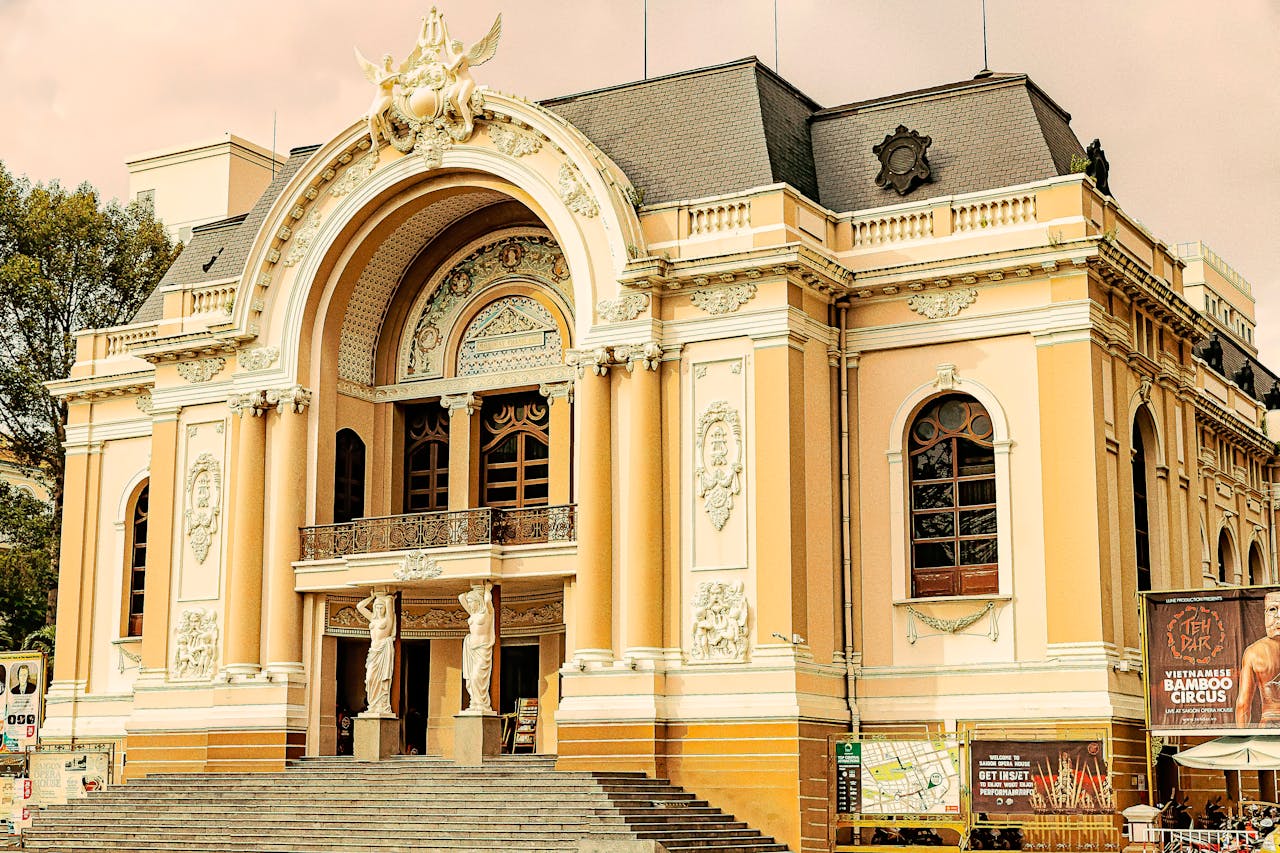
The Saigon Opera House is one of the most elegant buildings in Ho Chi Minh City and a remarkable example of French colonial architecture. Built in 1897, this magnificent structure reflects the Neo-Renaissance style introduced by the French and features a grand façade. The Opera House is especially noted for its wide staircases, ornate columns, and graceful stained glass windows. It plays a significant role as one of the main venues for cultural events in Vietnam. This building offers an unforgettable experience for both tourists and art enthusiasts and attracts the attention of everyone visiting the city.
The interior of the Opera House is just as impressive as its exterior. Its spacious and high-ceilinged hall is adorned with elegant chandeliers and golden details. The stage hosts leading opera, ballet, and concert performances in the city. Contributing to Vietnam’s cultural life, this venue is also used for various artistic events, festivals, and concerts. The Opera House is more than just a performance space—it is a symbol of historical and cultural importance in Ho Chi Minh City. Visitors can embark on a historical journey and enjoy Vietnam’s art scene in the refined atmosphere of this elegant structure.
6. Ho Chi Minh Statue and People’s Committee Building
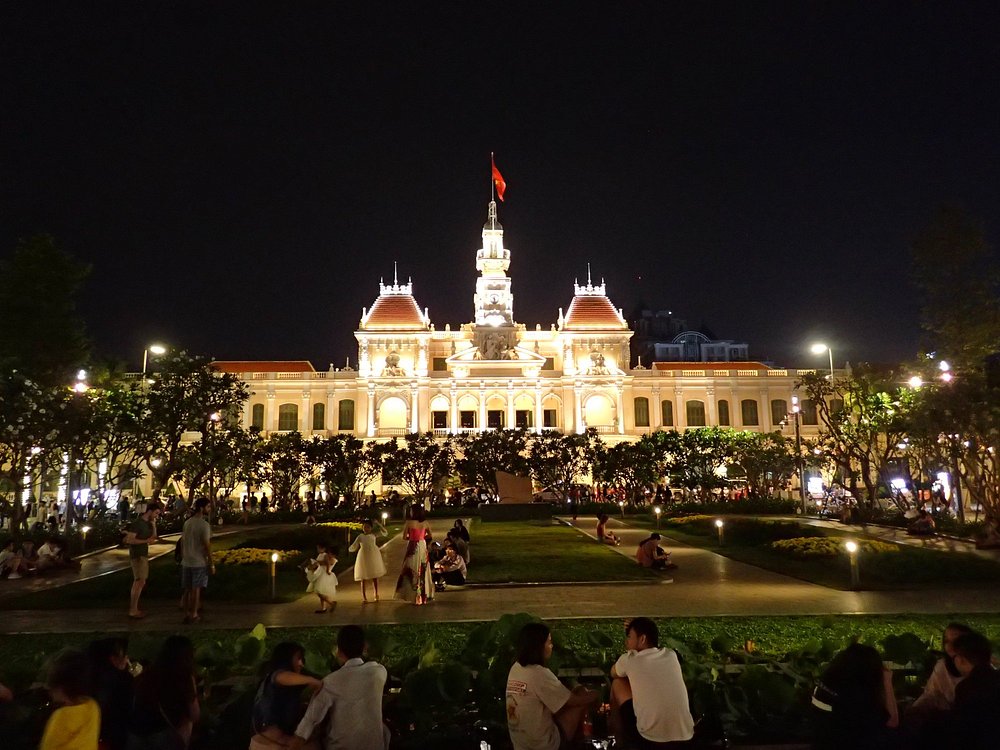
The Ho Chi Minh Statue and the People’s Committee Building are important symbols of the historical and cultural fabric of Ho Chi Minh City, located in the city center. The Ho Chi Minh Statue was erected in 1990 to honor the memory of Ho Chi Minh, the founder and leader of Vietnam’s independence. Positioned in the city’s central square, the statue represents a calm and respectful image of Ho Chi Minh. Surrounded by a large plaza, the statue has become a spot where both locals and visitors pay their respects, symbolizing the city’s connection between modern Vietnam and its historical roots. This statue is not only a monument but also a symbol of Vietnam’s national identity and its struggle for independence.
The People’s Committee Building is the elegant structure right next to the statue and is a significant building associated with Vietnam’s socialist governance. Built by the French in 1908, the building reflects the refined architecture of the French colonial era, adding both aesthetic and historical depth to the city. The building stands out with its wide balconies and open-air staircases. Today, it serves as the headquarters for the local government of Ho Chi Minh City. Both the Ho Chi Minh Statue and the People’s Committee Building offer visitors a profound historical experience as symbolic structures representing the city’s history, culture, and Vietnam’s fight for independence.
7. Binh Tay Market and Chinatown (Cholon)
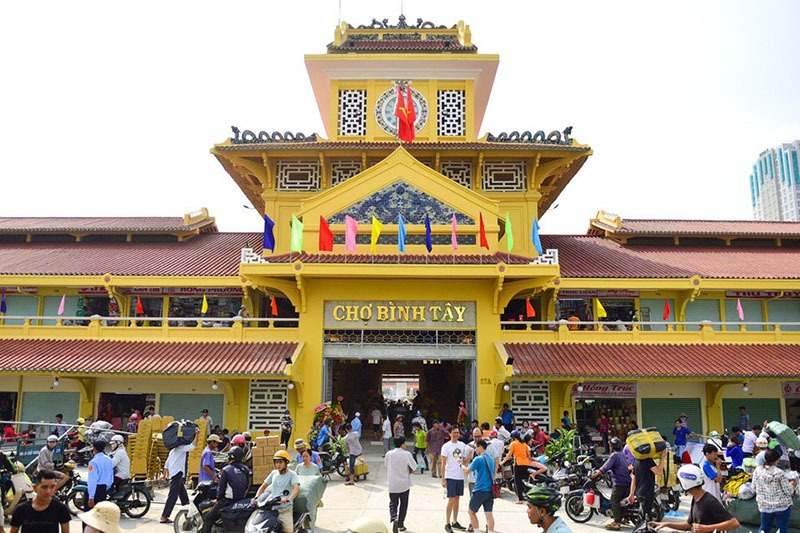
Binh Tay Market is a colorful and historic market unique to Ho Chi Minh City, located in the Cholon district, which is known as the city’s Chinatown. Built in 1928, this large market reflects traditional Chinese architectural influences and is one of the oldest commercial centers in the area. Binh Tay Market offers a wide range of products through numerous shops and stalls, from traditional Chinese medicinal items to antiques. Fresh fruits, spices, seafood, Chinese food products, and souvenirs are particularly popular here. While shopping, visitors feel they are not only engaging in commerce but also becoming part of the cultural fabric of the area.
Cholon is home to the largest Chinese community in Vietnam, and its streets are filled with temples, traditional shops, and impressive architectural structures that reflect Chinese culture. The narrow streets surrounding Binh Tay Market offer visitors the chance to explore traditional Chinese life more closely. Religious structures such as Taoist temples and Buddha statues also hold a significant place in the area. Cholon is one of the most culturally rich areas where Chinese culture is deeply present in Vietnam, offering a historically and culturally immersive experience. By shopping and walking through the streets, visitors have the opportunity to discover the history and culture of this area more deeply.
8. Jade Emperor Pagoda
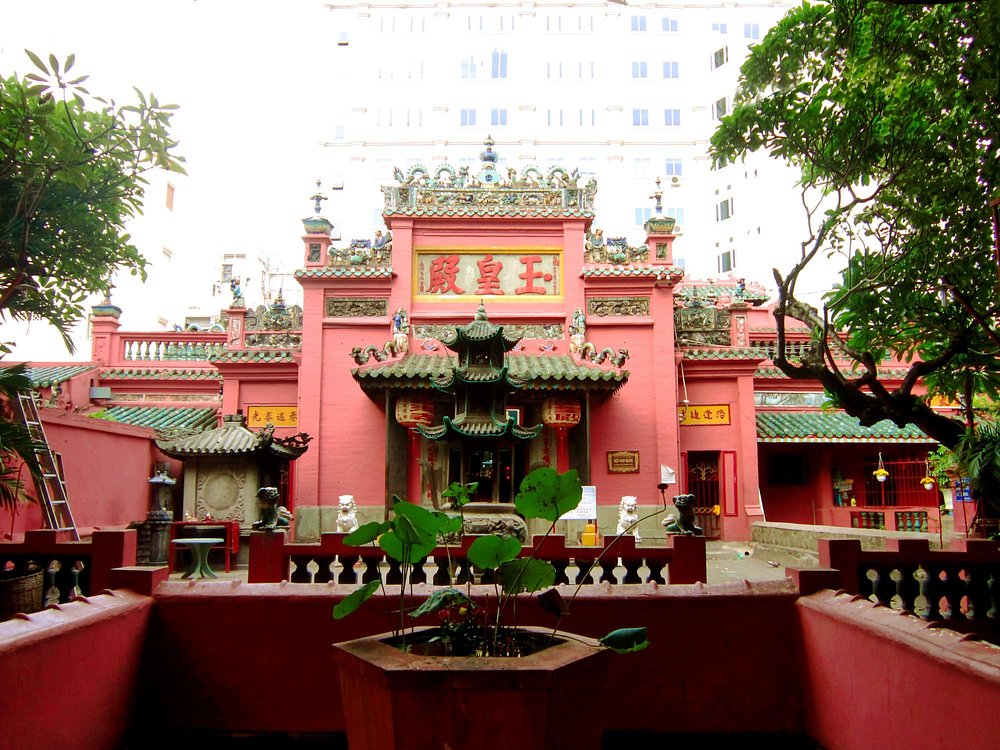
The Jade Emperor Pagoda is one of the most important and impressive temples in Ho Chi Minh City. Built in 1909, this Taoist temple serves as both a religious center and a cultural heritage site for those visiting the city. The temple was constructed in honor of the Jade Emperor, a prominent figure in Chinese mythology, and houses numerous statues and figures dedicated to him. The interior of the temple is adorned with detailed carvings, colorful figures, and golden accents, offering visitors a peaceful and mystical atmosphere. The grandeur of the temple and its religious artifacts have made it a significant symbol reflecting the cultural and religious beliefs of the Chinese community in Vietnam.
Beyond being a place of worship, the temple is also an important representative of Chinese culture in Ho Chi Minh City. A variety of rituals are performed here in accordance with Taoist beliefs, and each year many people visit the temple with wishes for health, luck, and happiness. During the Chinese New Year in particular, the temple sees a large number of visitors and hosts various religious celebrations. Visitors to the Jade Emperor Pagoda experience not only a spiritual journey but also gain a deeper understanding of Taoist traditions in Vietnam. With its religious significance and architectural beauty, the temple is an unforgettable destination for anyone visiting the city.
9. Tan Dinh Church
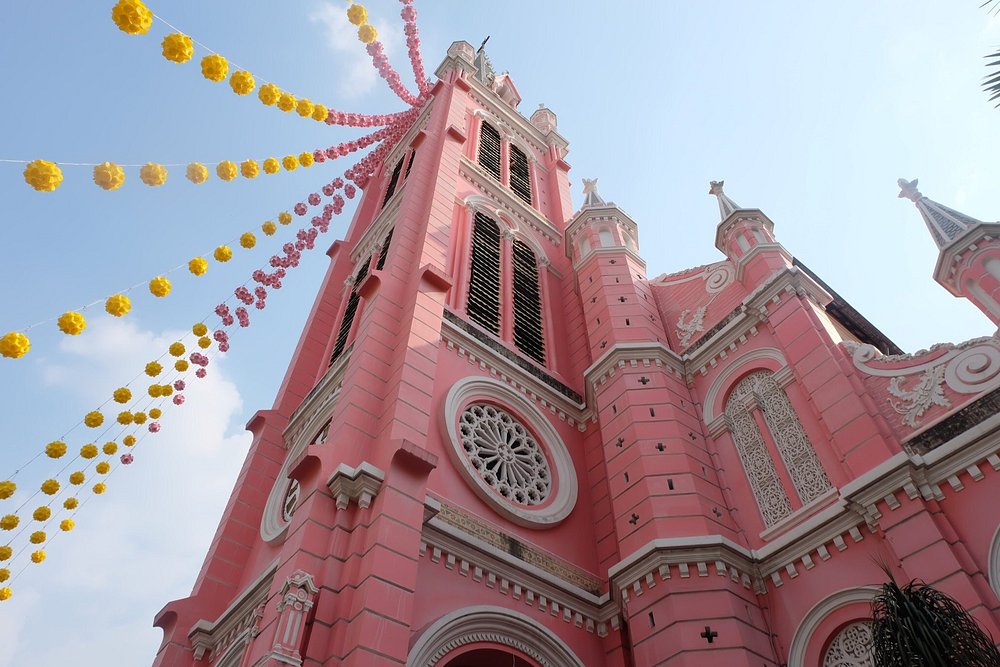
Tan Dinh Church is one of the most striking and colorful religious structures in Ho Chi Minh City. Built in 1950, the church is famous for its pink color, which draws the attention of visitors to the city. Constructed in the Neo-Renaissance style, the church also incorporates elegant elements of Gothic architecture. The building is shaped like a large cross and is notable for its tall roof, large stained glass windows, and graceful decorations. Tan Dinh Church is not only admired for its architecture but also serves as an important religious center for the local community. With weekly masses and religious ceremonies, it has become a place of worship for the Christian community and a spiritual gathering point for visitors.
The area surrounding the church offers a peaceful atmosphere, and the colorful flowers and gardens outside reflect how beloved this place is. Especially for photography enthusiasts, the unique pink color and captivating architecture of Tan Dinh Church make it one of the most eye-catching and Instagram-friendly spots in Ho Chi Minh City. Visitors experience more than just a religious site here—they also gain deeper insight into the city’s historical and cultural fabric. Nestled within the modern cityscape, Tan Dinh Church offers a unique sense of peace and beauty, standing apart from other iconic landmarks in the city.
10. Tao Dan Park
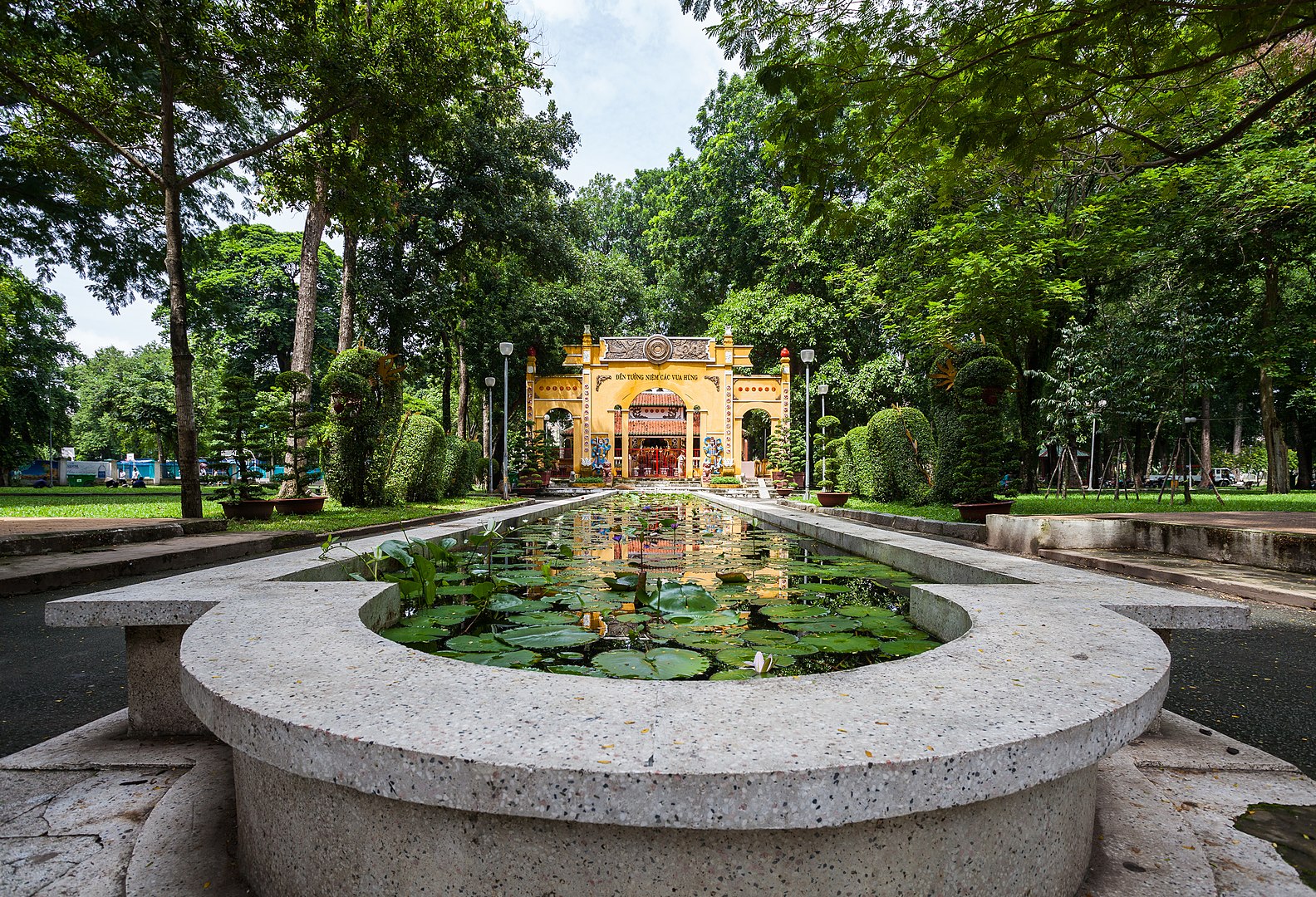
Tao Dan Park is a 10-hectare green space located in the center of Ho Chi Minh City, just behind the Reunification Palace. Built by the French in the 1860s, the park was originally known as the “Jardin de la Ville” and gradually became one of the city’s most important social spaces. Today, the park is considered one of the symbols of Vietnam’s struggle for independence and serves as an ideal place for those seeking to escape the city’s noise and be in touch with nature.
From early in the morning, the park is a popular spot for Saigon residents to exercise and start the day with activities like Tai Chi or yoga. It also features playgrounds for children, walking paths, and areas adorned with various statues. Particularly in the early hours, traditional social activities such as the “Bird Café,” where bird enthusiasts gather in the park’s secluded corners to display their birds, can also be observed.
🛍️ Shopping and Street Culture
11. Bến Thành Market
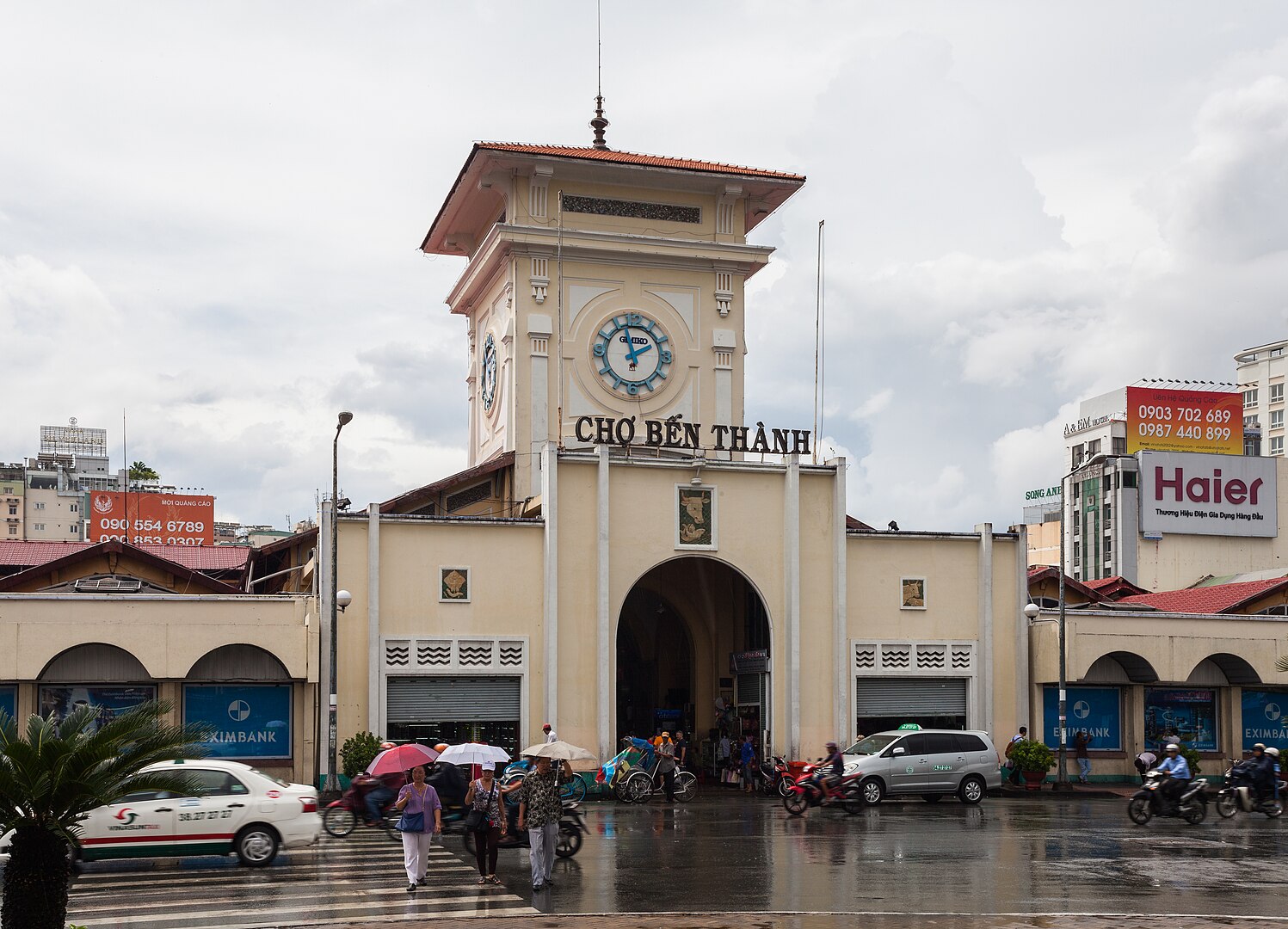
Bến Thành Market, located in the heart of Ho Chi Minh City (formerly Saigon) at Quách Thị Trang Square, is one of the city’s most iconic landmarks. Established in the 17th century to serve visitors and soldiers arriving at the Gia Định Citadel, the market gradually became the region’s most important commercial hub.
After a fire destroyed the original structure in 1870, the current building was constructed by the French between 1912 and 1914. Today, Bến Thành Market operates as a shopping and cultural center that attracts both locals and tourists, covering an area of 13,056 m² with over 1,500 stalls and more than 10,000 visitors daily.
The market’s architecture reflects the influence of the French colonial era, with its iconic clock tower on the front façade recognized as a city symbol. There are four main entrances and twelve side entrances, each specializing in different product categories. The south entrance is known for textiles and souvenirs, the east for cosmetics, the north for fresh fruits and seafood, and the west for handicrafts and ceramics.
Bến Thành Market is not only a place for shopping but also ideal for those who want to experience Vietnamese cuisine. Inside, traditional dishes such as pho, banh mi, and com tam are served, along with various juices and desserts. In the evening, food and souvenir stalls are set up around the market, transforming the surrounding streets into a vibrant night market.
Bến Thành Market is a must-visit destination that offers a combined experience of Ho Chi Minh City’s history, culture, and daily life. Visitors have the opportunity to shop while also discovering Vietnam’s rich cultural heritage.
12. Nguyễn Huệ Walking Street
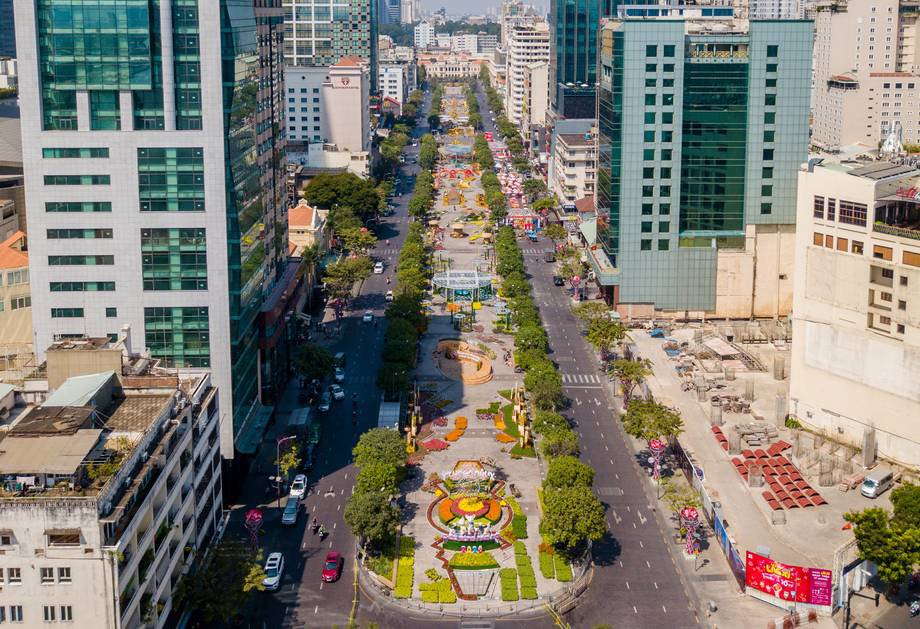
Nguyễn Huệ Walking Street is one of the most important pedestrian streets in the heart of Ho Chi Minh City (Saigon). Stretching approximately 670 meters in length and 64 meters in width, the street connects the Ho Chi Minh City Hall (People’s Committee Building) to the Saigon River. Fully closed to vehicle traffic in 2015, the street has become a symbol of Vietnam’s modernization process.
In the evenings, the street transforms into a captivating space with colorful lighting, water features, and floral arrangements. Today, it functions as a vibrant cultural hub, attracting both locals and tourists with street performers, music bands, and dance shows. The surrounding cafés and restaurants also offer visitors a chance to relax and enjoy the flavors of Vietnamese cuisine. Nguyễn Huệ Walking Street, combining both historical and modern aspects of the city, has become an essential destination for anyone seeking to experience the spirit of Ho Chi Minh City.
13. Ho Chi Minh Book Street
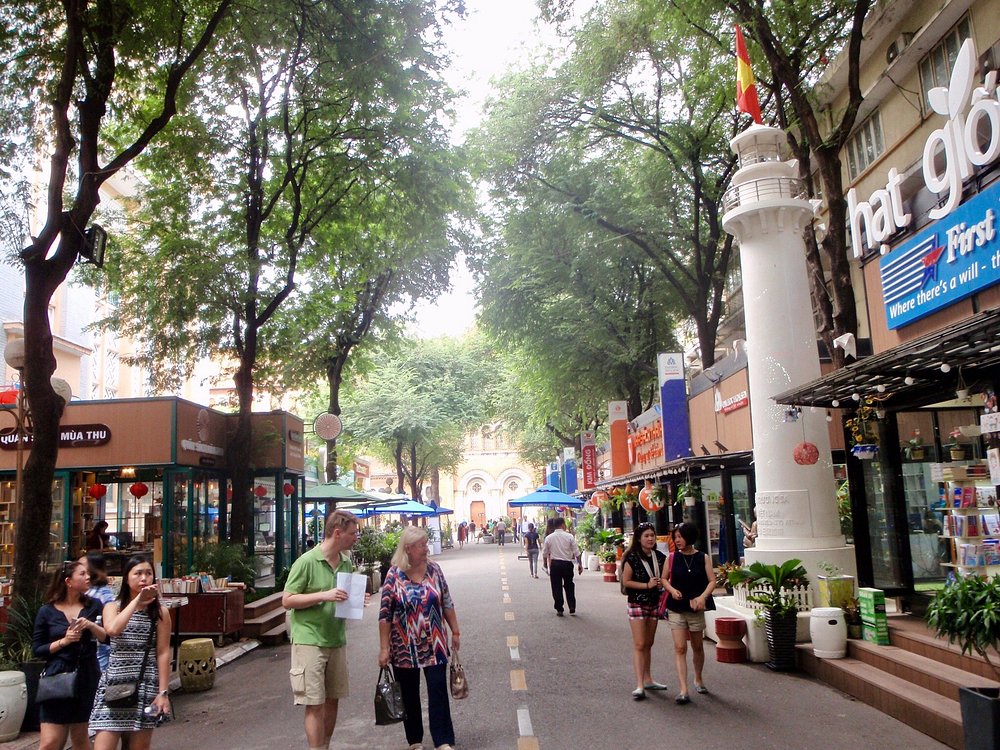
Ho Chi Minh Book Street is a 100-meter-long pedestrian street located in the heart of the city center, stretching between Hai Bà Trưng Street and Notre-Dame Cathedral. Officially known as Nguyễn Văn Bình Book Street, it was opened in 2016 as Vietnam’s first open-air book street complex. The street features more than 20 stalls representing Vietnam’s leading publishing houses, including Kim Đồng, Nha Nam, Thái Hà, Alphabooks, and the Ho Chi Minh City Publishing House. Visitors can find a wide range of works here, covering literature, history, art, science, children’s books, and foreign language publications.
Book Street is popular not only for book shopping but also as a place to relax and participate in cultural activities. In addition to bookstores, the street includes old book exchange spots, magazine and newspaper stands, stationery items, and photography galleries. Café bookstores such as Phương Nam Book Coffee and Ban Coffee offer a peaceful atmosphere for reading and enjoying coffee. On weekends, events such as author meet-and-greets, book signings, and acoustic music performances are held.
14. Tôn Thất Đạm Apartment
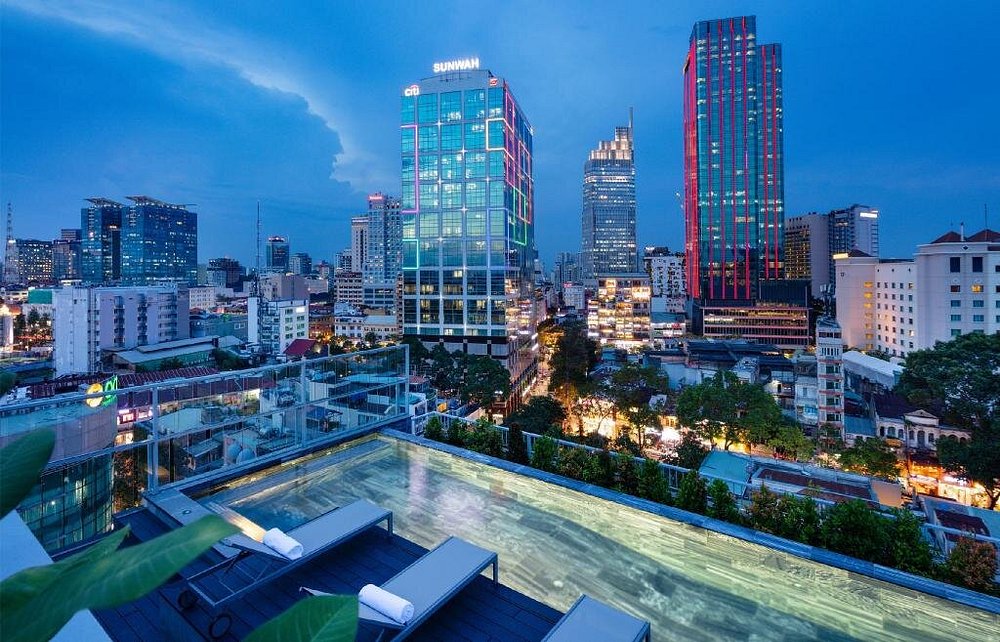
Tôn Thất Đạm Apartment is a historic residential complex located in District 1, in the center of Ho Chi Minh City (Sài Gòn). Built around 1886 during the French colonial period, the building features one ground floor and four upper floors, reflecting the architectural characteristics of that era. Despite the city’s rapid modernization, the apartment preserves traces of the past and offers a peaceful living environment.
The apartment serves not only as a residence but also as a cultural hub. It houses many cafés, boutiques, and vintage shops that attract young people and tourists with their nostalgic atmosphere. Places like Mockingbird Cafe, Hoàng Thị Cafe, and Man Tu Zen Tea are especially popular for their tranquil ambiance and rooftop views of the city. In addition, shops like OwlFox and Bụi Shop appeal to shoppers with their vintage and secondhand clothing. Tôn Thất Đạm Apartment offers both residents and visitors a peaceful and culturally rich experience that carries the marks of the past.
🌿 Nature and Entertainment
15. Đầm Sen Park

Đầm Sen Park is a massive 50-hectare entertainment complex located in the western part of Ho Chi Minh City (Sài Gòn), in District 11. Established in 1983, the park is one of Vietnam’s largest cultural and water park destinations, attracting both locals and tourists. The park is divided into two main sections: Đầm Sen Water Park and Đầm Sen Cultural Park. The Water Park features 36 different water slides and a 3,000 m² wave pool, making it an ideal place to cool off during the summer. The Cultural Park offers a variety of entertainment options with 30 themed areas.
Đầm Sen Cultural Park includes diverse zones such as the Roman Square, a water palace with choreographed shows, a monorail train, and the ancient Giác Viên Pagoda. Natural attractions like a 22-meter-high rock garden, an orchid garden, and habitats for tropical birds are also part of the park. Visitors can enjoy both fun-filled activities and experiences in close contact with nature. Đầm Sen Park is a popular entertainment spot for families and groups of friends in Vietnam and is an ideal destination for those looking to escape the city noise and enjoy a pleasant day.
16. Bitexco Skydeck (Saigon Skydeck)

Bitexco Skydeck is an observation deck located on the 49th floor of the Bitexco Financial Tower in the Bến Nghé area of central Ho Chi Minh City. Standing at 262.5 meters tall, the building held the title of Vietnam’s tallest skyscraper when completed in 2010 and is currently the second tallest in the city. Its architectural design was inspired by Vietnam’s national flower, the lotus, which enhances the building’s modern and distinctive appearance.
The Skydeck offers visitors a 360-degree panoramic view of the city. High-speed elevators, traveling at 7 meters per second, transport guests from the ground floor to the 49th floor. Visitors can enjoy the view through telescopes and learn about the city’s key landmarks via interactive displays. Additionally, the Ao Dai Gallery showcases traditional Vietnamese attire. The entrance fee is approximately 240,000 VND (around 10 USD), and tickets can be purchased both on-site and online.
17. Landmark 81
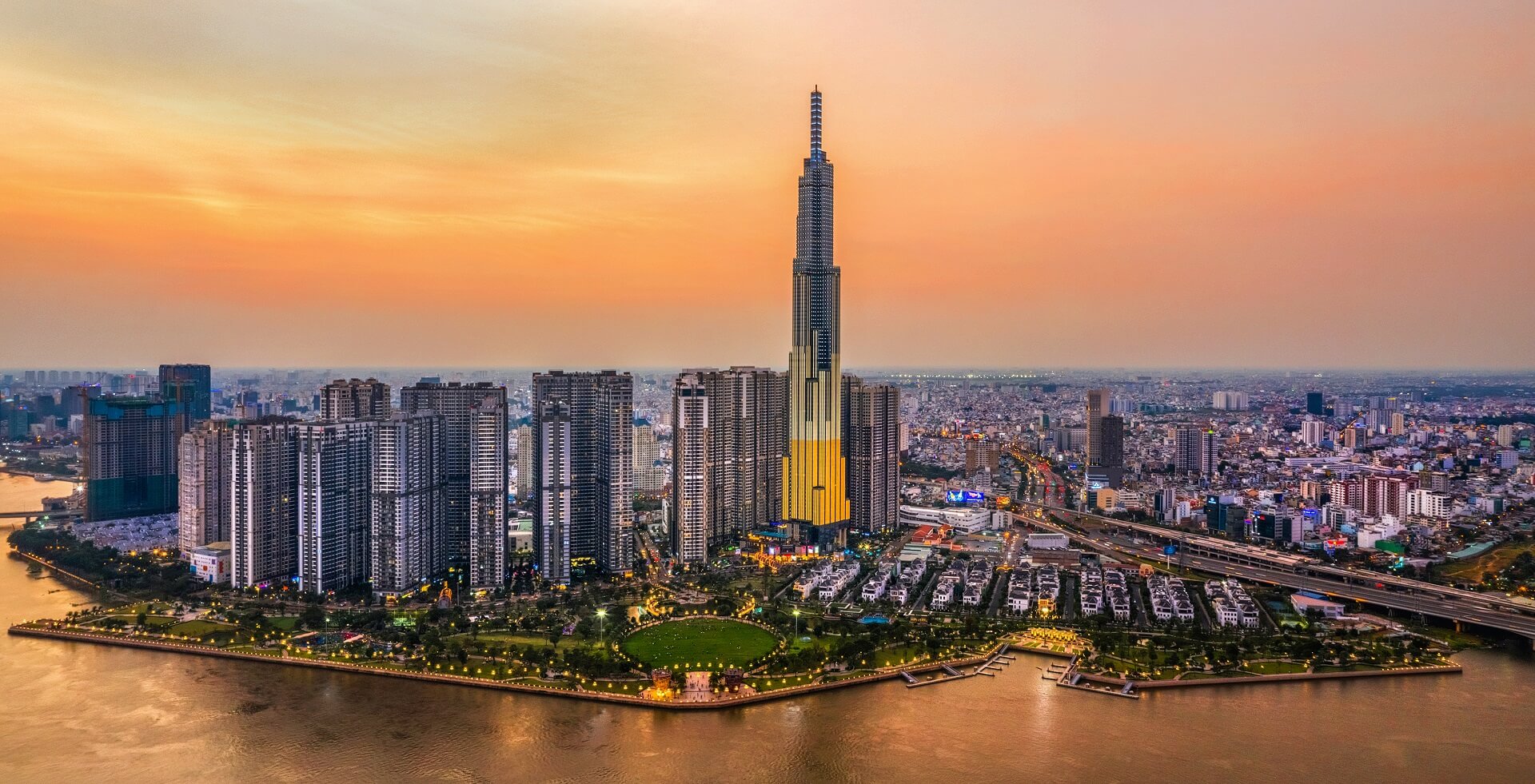
Landmark 81, located in the Binh Thạnh District of Ho Chi Minh City within Vinhomes Central Park, is the tallest building in Vietnam, completed in 2018. At a height of 461.2 meters, this 81-story skyscraper is also the second tallest building in Southeast Asia. Its architectural design was inspired by the shape of a bundle of bamboo, symbolizing strength and unity in Vietnamese culture. The building’s exterior is covered with Low-E glass to enhance energy efficiency and spans a total area of 241,000 m².
Landmark 81 is a multifunctional structure: the ground to the 3rd floor houses the Vincom Center shopping mall, while floors 4 to 41 are luxury residences. The Vinpearl Luxury Landmark 81 hotel occupies floors 47 to 77, and the SkyView observation deck on floors 79 to 81 offers visitors a panoramic view of Ho Chi Minh City.
Additionally, restaurants and bars are located on floors 66 and 67, and an infinity pool can be found on the 47th floor. Admission to the SkyView observation deck is priced at 810,000 VND (approximately 34.80 USD) for adults and 403,000 VND (approximately 17.40 USD) for children.
18. Mekong Delta Tour
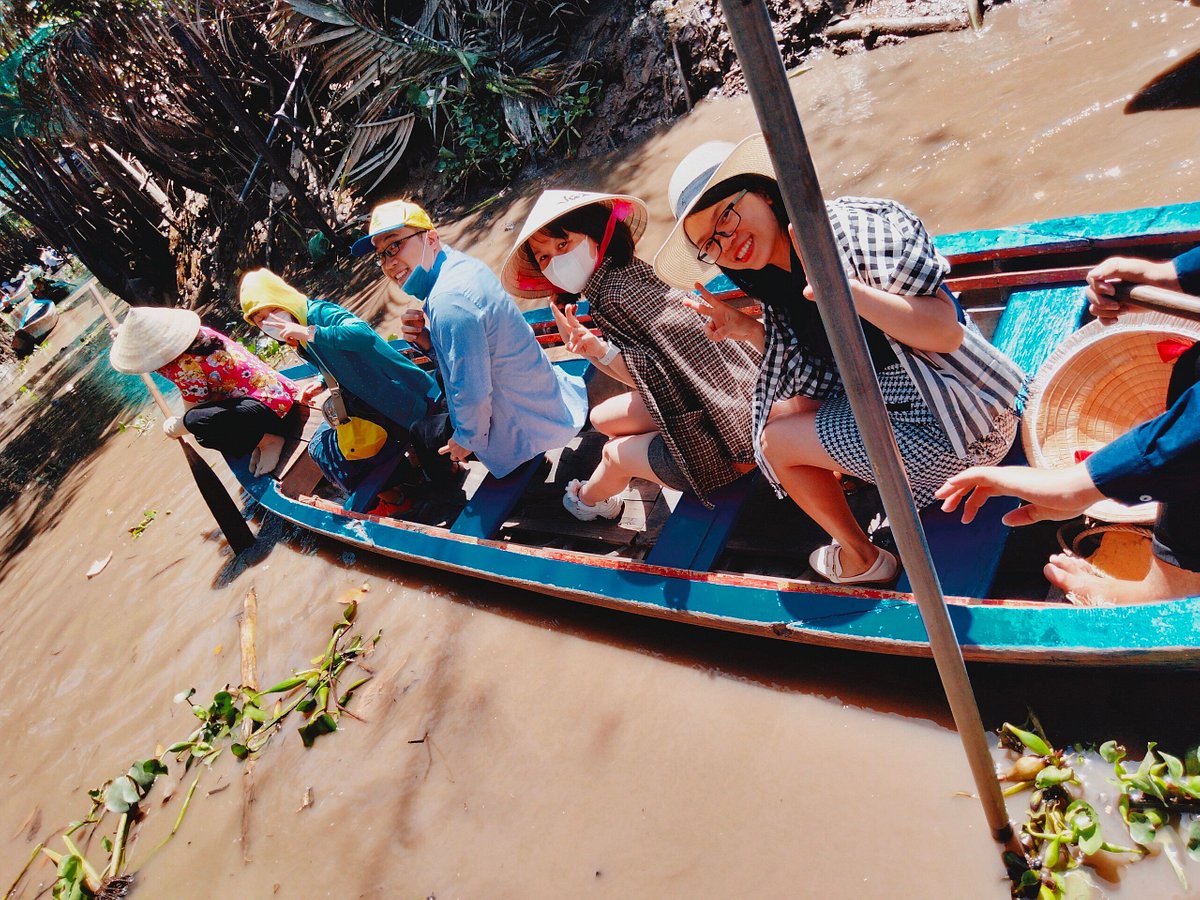
The Mekong Delta Tour offers the opportunity to explore a region in southern Vietnam known for its tropical nature, waterways, and unique culture, accessible via day trips or multi-day tours from Ho Chi Minh City. Tours usually start early in the morning and end in the evening, with lunch included. In addition to visiting historical sites such as Vinh Trang Pagoda, participants can enjoy boat rides along narrow canals, observe traditional handicraft workshops, and interact with local residents. Tours typically begin with pickup from your hotel in Ho Chi Minh City and allow you to experience the region’s tranquil lifestyle.
The Mekong Delta is known as Vietnam’s “rice bowl” and produces a significant portion of the country’s rice. The area is famous for its fertile agricultural lands, tropical fruit orchards, and extensive waterways. While discovering the cultural richness of the region, visitors can take traditional boat tours, visit local markets, and taste regional delicacies. The Mekong Delta Tour offers an unforgettable experience for those who wish to explore this unique part of southern Vietnam.
19. Cu Chi Tunnels
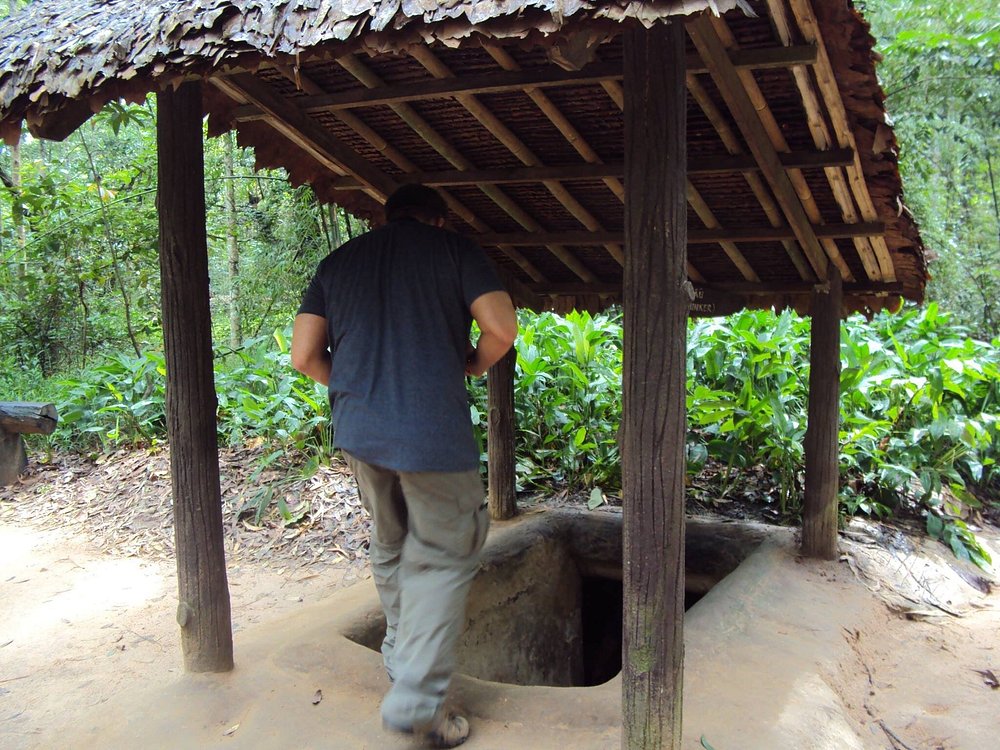
The Cu Chi Tunnels are an extensive underground tunnel network located in the Cu Chi district, about 40 kilometers northwest of Ho Chi Minh City. These tunnels, which held strategic importance during the Vietnam War, were initially dug by the Viet Minh in the late 1940s as a symbol of resistance against French colonial rule and were later expanded by the Viet Cong in the 1960s to stretch up to 250 kilometers. During the war, they were used for various purposes including hiding, supply routes, hospitals, kitchens, schools, and command centers. In addition, traps and defensive systems were developed to prevent American soldiers from entering the tunnels.
Today, the Cu Chi Tunnels serve as a significant tourist and educational site for visitors seeking to understand the history of the Vietnam War and the resistance strategies of the Viet Cong. Visitors can explore two main tunnel complexes: Ben Dinh and Ben Duoc. While Ben Dinh attracts more tourists, Ben Duoc is less crowded and offers a more authentic experience, featuring important structures like the Hoang Cam kitchen and the Ben Duoc Memorial Temple. Some sections of the tunnels have been widened and fitted with low lighting to allow visitors to explore. Walking through the narrow passages, visitors gain a closer understanding of the harsh living conditions and military strategies of the Viet Cong.
🍜 Food & Nightlife
20. Bánh mì Huỳnh Hoa
Bánh Mì Huỳnh Hoa is one of the most famous and most preferred banh mi shops in Ho Chi Minh City. Established in 1989, the venue is extremely popular among both tourists and locals. It operates from 6 a.m. to 10 p.m. and often sees long lines of customers. The most notable feature of Bánh Mì Huỳnh Hoa is the large size and richness of its sandwiches. A single banh mi is filling enough to satisfy two people. The sandwich is generously filled with pâté, Vietnamese ham, various meats, and special sauces. Additionally, it is flavored with ingredients like pickles, cucumber, and cilantro, offering a rich and well-balanced taste experience.
The popularity of Bánh Mì Huỳnh Hoa is due not only to its flavor but also to its preparation process. The interior of the shop is organized like a production line; one team prepares the bread, while another slices the meats and assembles the sandwiches. This fast and orderly process enhances customer satisfaction. However, some visitors have noted that the size and content of the sandwich may be too much, and they would prefer smaller portions. Nevertheless, Bánh Mì Huỳnh Hoa stands out as a must-visit spot for anyone looking to try banh mi in Ho Chi Minh City.
21. Cơm tấm Nguyễn Văn Cừ
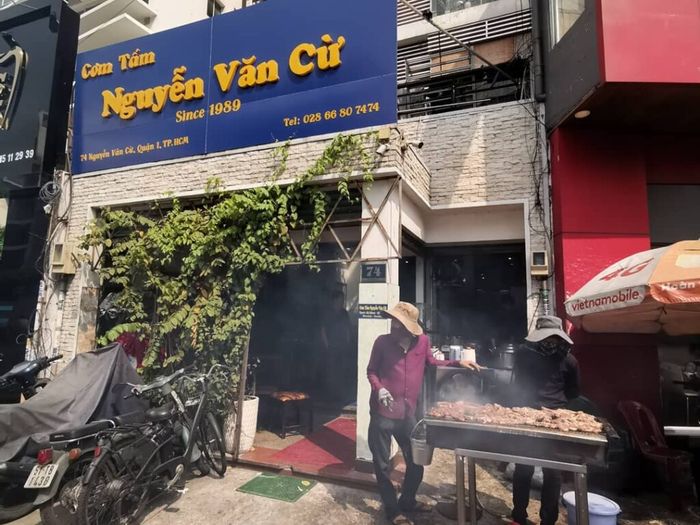
Cơm Tấm Nguyễn Văn Cừ is a famous cơm tấm restaurant located at 74 Nguyễn Văn Cừ Street in District 1 of Ho Chi Minh City. This establishment is particularly known for its large portions and rich variety. The traditional Vietnamese dish cơm tấm is served here with options such as sườn nướng (grilled pork ribs), bì (shredded pork skin), chả (Vietnamese-style omelet), and trứng (egg). Prices at the restaurant range from 50,000 VND to 150,000 VND, depending on portion size and ingredients used.
However, some visitors have noted that the prices are higher compared to other cơm tấm spots. For example, in a TikTok video, a portion priced at 180,000 VND was described as expensive. Still, many people consider the prices reasonable given the generous portions and flavorful dishes. Cơm Tấm Nguyễn Văn Cừ stands out as an ideal place for those seeking hearty portions and rich content.
22. XO Foodie Tour
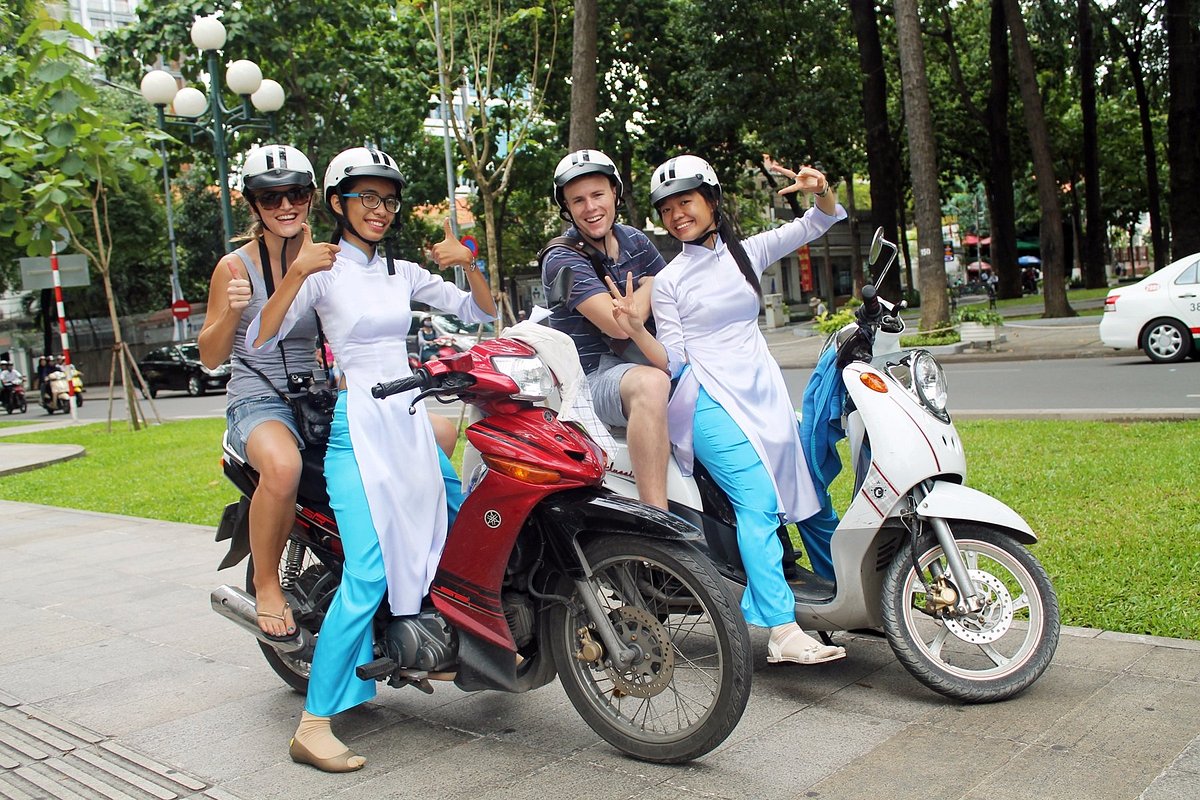
XO Foodie Tour offers a unique experience for those looking to explore the culinary culture of Ho Chi Minh City in depth. Established in 2010, XO Tours is Vietnam’s first female-led tour company and provides this nighttime motorbike tour to introduce participants to local flavors. Selected by Forbes as one of the top 9 food tours in the world, the experience promises a 4.5-hour gastronomic journey. The tour usually runs from 5:30 PM to 10:00 PM, during which participants ride on motorbikes through different neighborhoods accompanied by female guides dressed in traditional Ao Dai attire.
XO Foodie Tour is not only a food-focused experience but also an opportunity to explore various districts of Ho Chi Minh City. During the tour, vibrant markets in Chinatown, seafood streets, and Vietnamese barbecue spots are visited. Participants get to taste a wide variety of dishes such as Bún Bò Huế, grilled goat, scallops, and even embryonic duck egg. All food and drinks (water, tea, beer, soft drinks) are included in the tour fee, and portions are unlimited. Alternative menus are available for vegan, vegetarian, and food allergy-sensitive guests. The tour provides not only a delicious experience but also a chance to learn about Vietnamese culture and lifestyle.
23. Bui Viên Street
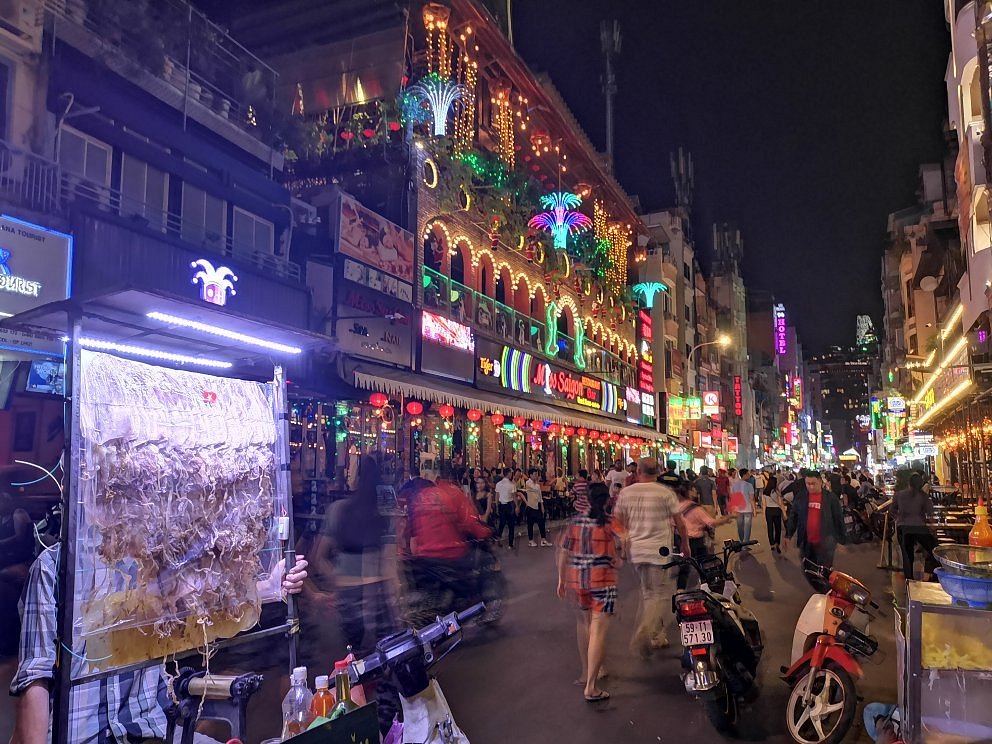
Bùi Viện Street is located in the Phạm Ngũ Lão neighborhood, one of the most vibrant and cosmopolitan areas of Ho Chi Minh City (Sài Gòn). Stretching approximately 650 meters, the street is also known in Vietnam as “Backpacker Street” or “Westerners’ Street” and is a popular destination for young travelers, nightlife enthusiasts, and street food seekers. In 2017, Bùi Viện was closed to vehicle traffic and turned into a pedestrian street, a change that further energized its nightlife scene.
The street’s atmosphere is filled with neon lights, street performers, and music. Surrounded by bars, cafés, restaurants, and nightclubs, Bùi Viện becomes very crowded during the evening hours. Visitors can enjoy both Vietnamese and Western cuisine, while street vendors offer fresh juices, ice cream, and various snacks. Additionally, street performances, dance shows, and live music events provide a colorful nightlife experience. Bùi Viện is an essential stop for those wanting to explore the energetic nightlife of Ho Chi Minh City.
24. Café Apartment (42 Nguyễn Huệ)
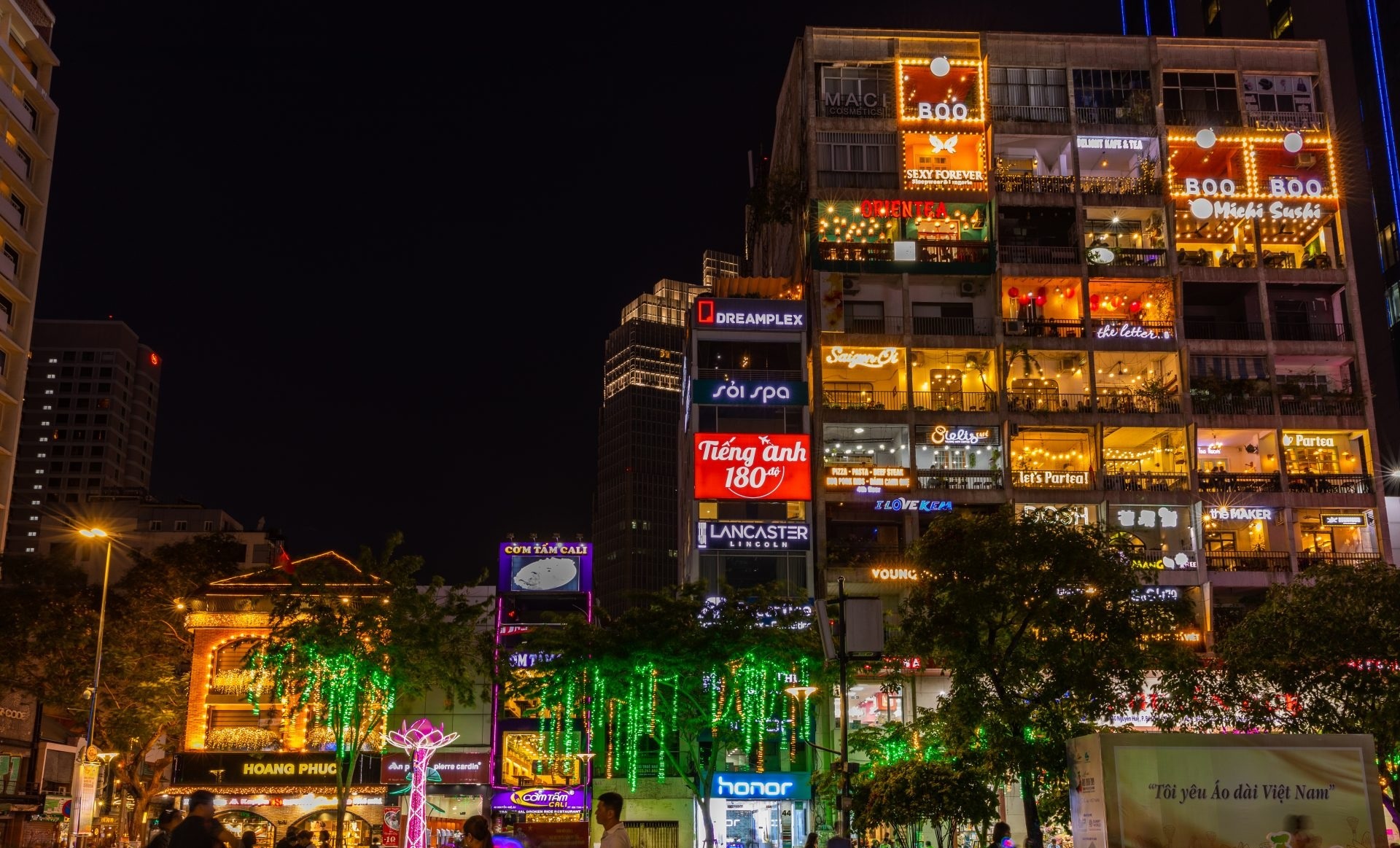
Cà phê Apartment is one of the most iconic and photogenic spots in Ho Chi Minh City (Sài Gòn). Located at 42 Nguyễn Huệ Street, this nine-story apartment building was constructed in the 1960s and was used during the Vietnam War by government officials and American military advisors. In 2015, as rental costs increased, small cafés and boutiques moved into the old building, revitalizing it and turning it into one of the city’s most popular social and cultural meeting points.
Today, Cà phê Apartment houses around 30 independent cafés, boutiques, art galleries, and co-working spaces, each offering a unique atmosphere and concept. Visitors discover a different experience on every floor and are especially enchanted by the building’s lighting and lively vibe in the evening. The site attracts both locals and tourists and is a favorite location for social media posts.
🏺 Museums and Art
25. Ho Chi Minh City Museum
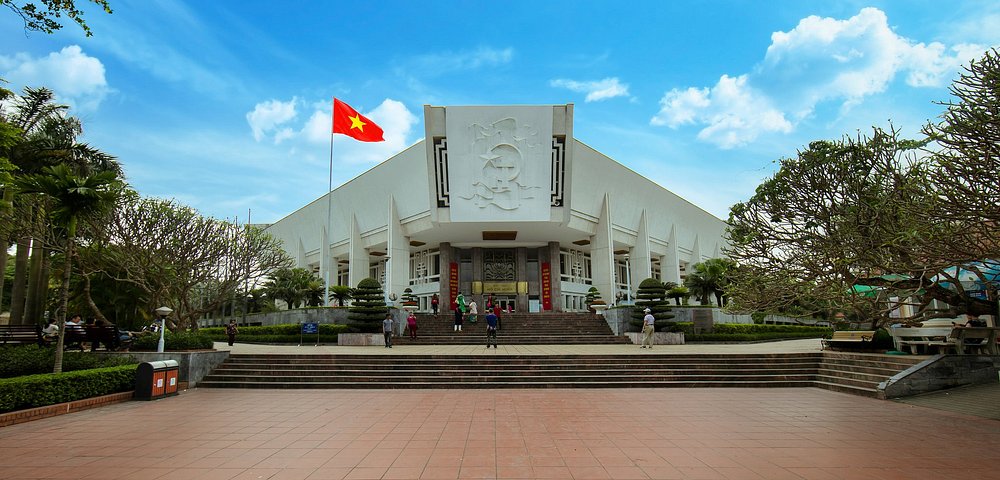
The Ho Chi Minh City Museum (Vietnamese: Bảo tàng Thành phố Hồ Chí Minh) is an important destination for those who want to explore the city’s history in depth. Located at 2 Nguyễn Bỉnh Khiêm Street in District 1, the museum is housed in the Gia Long Palace, which was built in 1885 by French architect Alfred Foulhoux. The building stands out with its elegant Baroque-style architecture from the French colonial period and was converted into a museum in 1978.
The museum features an extensive collection that covers various periods of Vietnam’s history. Exhibits span from prehistoric times through Chinese rule, the Champa Kingdom, Khmer culture, feudal dynasties, the French colonial era, and the Vietnam War. Stone sculptures from the Champa and Khmer periods and artifacts from the Oc Eo culture are among the highlights of the museum’s collection. Additionally, the outdoor area displays war relics and vehicles related to the resistance against the French and Americans.
Visitor Information:
Address: 2 Nguyễn Bỉnh Khiêm, District 1, Ho Chi Minh City, Vietnam
Opening Hours: Daily, 08:00–17:00
Entrance Fee: 30,000 VND (approximately 1.20 USD)
Photography Fee: An additional 20,000 VND for professional cameras
The Ho Chi Minh City Museum is an essential stop for anyone wishing to understand the cultural and historical heritage of the city.
26. Vietnam History Museum
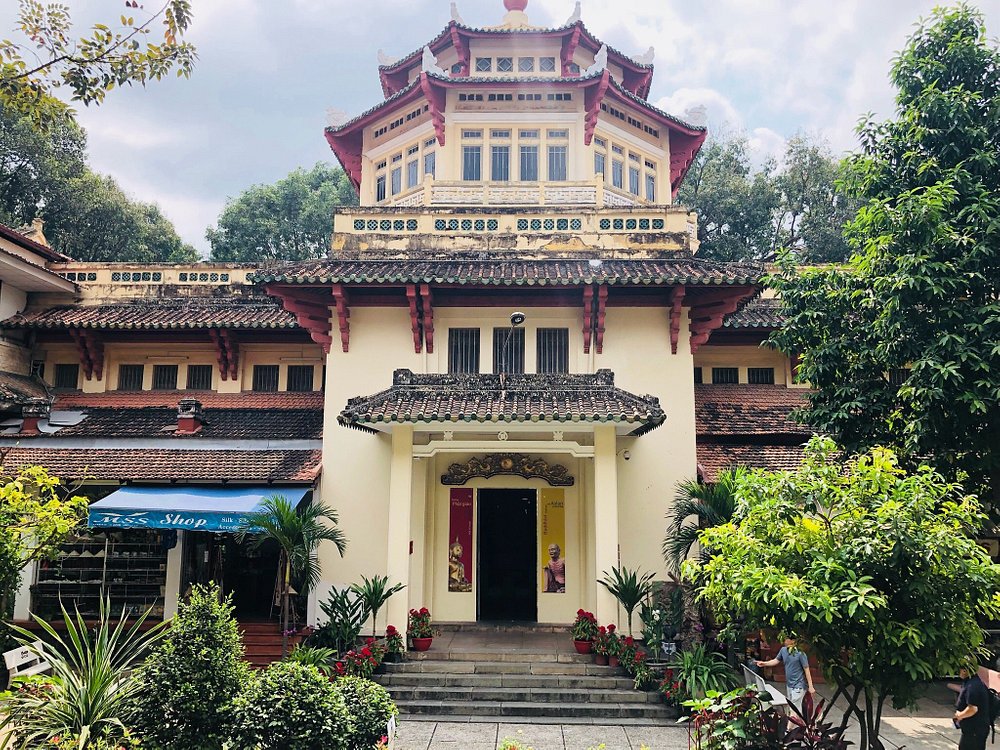
The Vietnam History Museum in Ho Chi Minh City (Vietnamese: Bảo tàng Lịch sử Thành phố Hồ Chí Minh) is one of the city’s oldest and most comprehensive museums. Built by the French in 1929, the building was originally known as the Musée Blanchard de la Brosse and is considered the first museum in southern Vietnam. It was reopened as the Vietnam History Museum in 1981 and received its current name in 1987. The museum is located at 2 Nguyễn Bỉnh Khiêm Street in the Bến Nghé ward of Ho Chi Minh City, next to the Saigon Zoo and Botanical Gardens.
The museum offers a rich collection for those wishing to explore Vietnam’s history in depth. Exhibits cover a wide range of periods from prehistoric times through Chinese domination, the Champa Kingdom, Khmer culture, feudal dynasties, the French colonial era, and the Vietnam War. Stone sculptures from the Champa and Khmer periods, along with artifacts from the Oc Eo culture, are among the museum’s highlights. It is also an important cultural center that showcases Vietnam’s ethnic diversity and cultural heritage.
Visitor Information:
Address: 2 Nguyễn Bỉnh Khiêm, District 1, Ho Chi Minh City, Vietnam
Opening Hours: Tuesday–Sunday: 08:00–11:30 and 13:00–17:00; Closed on Mondays
Entrance Fee: 30,000 VND for adults; 15,000 VND for children aged 6–15; Free for children under 6
Phone: (028) 3829 8146
The Vietnam History Museum is a must-visit destination for those looking to understand the city’s historical and cultural background.
27. FITO Museum
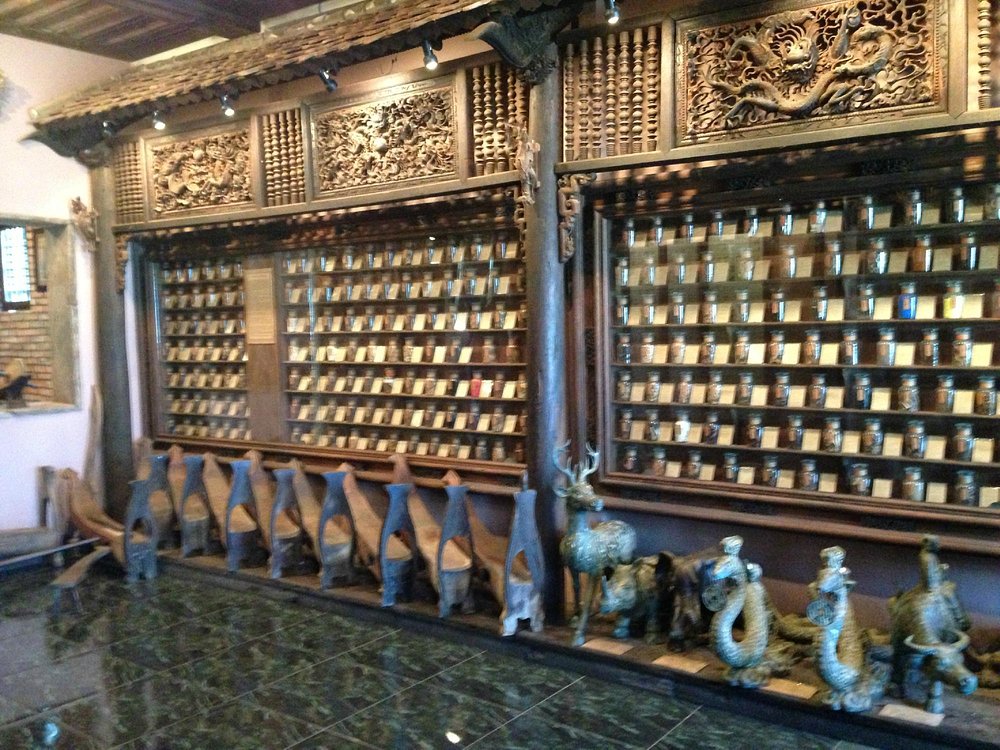
The FITO Museum (Vietnamese: Bảo tàng Y học Cổ truyền Việt Nam), located at 41 Hoàng Dư Khương Street in District 10 of Ho Chi Minh City, is Vietnam’s first private museum dedicated to traditional medicine. Established in 2003 and opened to the public in 2007, the museum offers a unique experience for those who wish to explore the history and practices of Vietnam’s rich heritage in herbal medicine.
Housed in a six-story building covering 600 m², the museum features approximately 3,000 rare and historical medical artifacts across 18 exhibition rooms. Visitors can explore a collection that spans from the Stone Age to the present day, including traditional treatment methods, herbal medicines, acupuncture tools, and old pharmacy equipment. The museum also includes a shrine dedicated to renowned medical scholars such as Zen Master Tue Tinh and Hai Thuong Lan Ong (Le Huu Trac).
Visitor Information:
Address: 41 Hoàng Dư Khương, Ward 12, District 10, Ho Chi Minh City, Vietnam
Opening Hours: Daily except Sunday, 08:30–17:00
Entrance Fee: 120,000 VND for adults; 60,000 VND for children and students
Phone: (028) 3864 2440
Website: fitomuseum.com.vn
It is a must-visit place in Ho Chi Minh City for those interested in discovering herbal treatment methods.
🛶 Unique Experiences
28. Street Food Tour
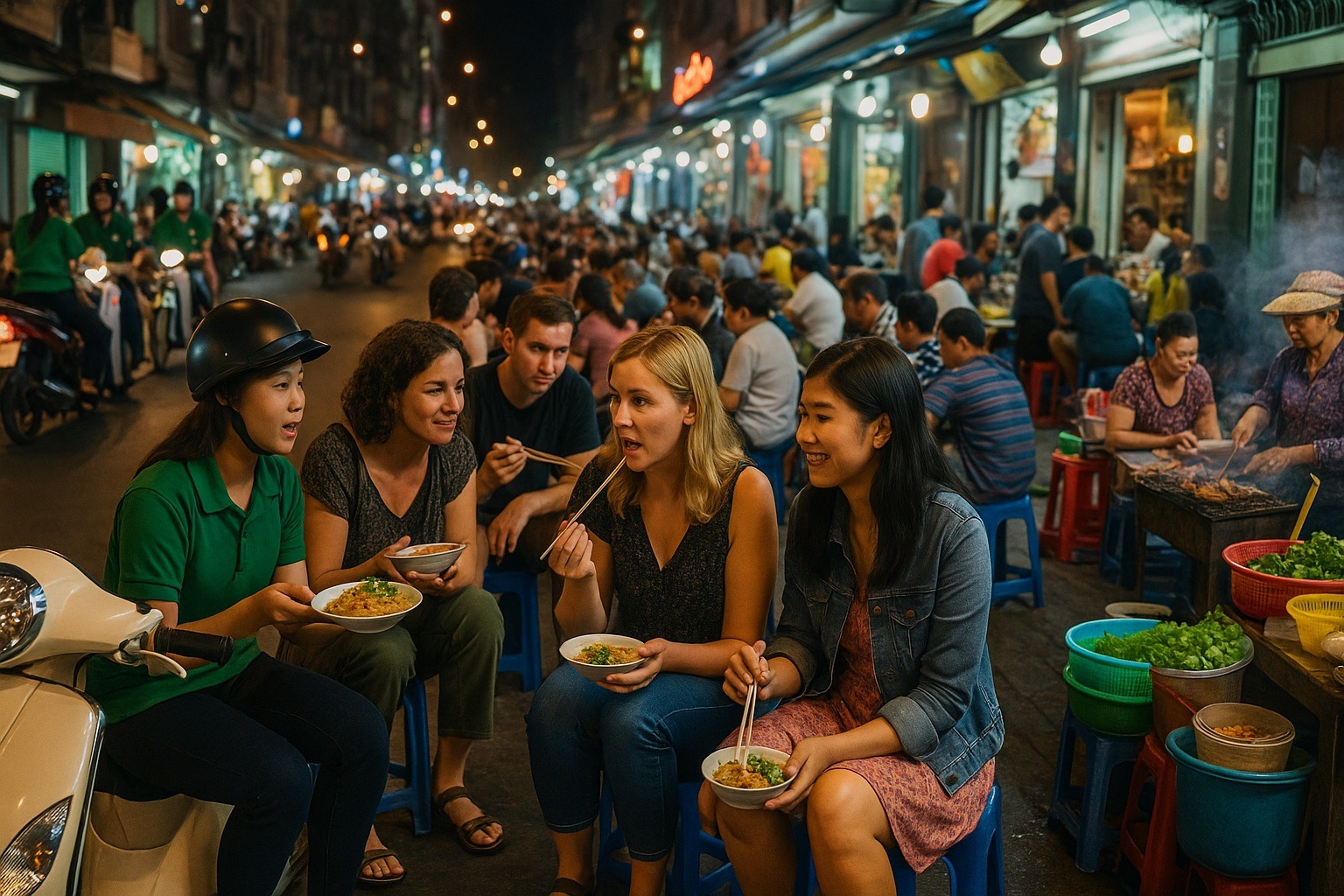
Ho Chi Minh City boasts one of the most dynamic and colorful street food scenes in Vietnam. The city offers a rich gastronomic mosaic shaped not only by traditional Vietnamese cuisine but also by French, Chinese, and Khmer influences. In addition to iconic dishes like bánh mì, phở, cơm tấm, and bún bò Huế, a variety of snacks and desserts sold by street vendors provide visitors with an unforgettable experience.
Street food tours are an excellent way to explore these flavors. Notable tours include the evening motorbike tour by XO Tours, culturally and historically enriched walking tours by Saigon Street Eats, and student-guided food tours by Saigon Vibes. These tours typically last between 3.5 and 4.5 hours and include 10 to 15 different dishes. Tours usually begin in areas such as Districts 1, 3, and 4 and feature visits to local markets, street vendors, and hidden culinary gems. Street food tours offer an unforgettable experience for those who wish to explore Vietnamese cuisine in depth.
29. Night Tour
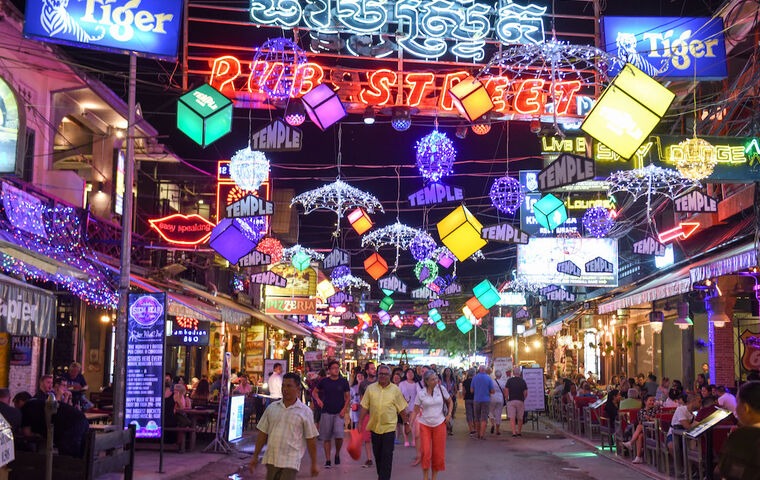
Ho Chi Minh City’s nightlife offers unique opportunities for those who want to explore the city from a different perspective. As the heat of the day gives way to cooler evening hours, the streets and riverbanks come alive with a vibrant atmosphere. Night tours combine both tourist and local experiences, providing visitors with unforgettable moments.
Popular night tours in the city include motorbike rides, walking tours, and river cruises. For example, XO Tours’ “Saigon by Night” takes participants through four different districts, offering the chance to taste local street food and explore Vietnamese culture in depth. This motorbike tour, guided by female drivers, has hosted over 100,000 participants since 2010. Another option is the Saigon River Boutique Cruise, a boat tour along the Saigon River that allows visitors to see the city illuminated at night. There are also night bus tours; City Sightseeing offers an open-top double-decker bus ride that highlights the city’s landmarks under night lights.
Night tours are not just about seeing the city—they also offer the chance to experience Vietnam’s rich culture and cuisine. Exploring the city in the calm of the evening, away from the daytime crowds, is an ideal option for those wishing to view Ho Chi Minh City from a different perspective.

